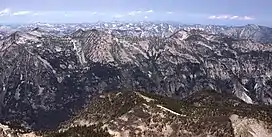Bitterroot Range
The Bitterroot Range is a mountain range and a subrange of the Rocky Mountains that runs along the border of Montana and Idaho in the northwestern United States. The range spans an area of 24,223 square miles (62,740 km2) and is named after the bitterroot (Lewisia rediviva), a small pink flower that is the state flower of Montana.[1][2]
| Bitterroot Range | |
|---|---|
 Part of the Bitterroot Range in Montana, looking north from El Capitan peak | |
| Highest point | |
| Peak | Trapper Peak |
| Elevation | 10,157 ft (3,096 m) |
| Coordinates | 44°21′14″N 112°49′17″W |
| Dimensions | |
| Length | 304 mi (489 km) N/S |
| Width | 268 mi (431 km) E/W |
| Area | 14,742 sq mi (38,180 km2) |
| Geography | |
 Bitterroot Range | |
| Country | United States |
| States | Idaho and Montana |
| Parent range | Rocky Mountains |
History
In 1805, the Corps of Discovery, led by Meriwether Lewis and William Clark and aided by Sacajawea of the Shoshone tribe, crossed the Bitterroot Range several times. Lewis first crossed the mountains at Lemhi Pass on August 12, then returned across the pass to meet Clark. The entire expedition then crossed the pass to the Salmon River valley, and the next month entered the Bitterroot Valley from the south via either Lost Trail Pass or Chief Joseph Pass. It then crossed Lolo Pass to the west. The mountains were crossed by the Chicago, Milwaukee, St. Paul and Pacific Railroad (the "Milwaukee Road").[3]
Ranges
According to the U.S. Board on Geographic Names, the Bitterroot Range runs from Pend Oreille Lake (near Sandpoint, Idaho) to Monida Pass,.[4] It is sometimes considered to extend east of the Monida Pass to include the Centennial Mountains. The range comprises the following subranges (from north to south):
Coeur d'Alène Mountains
The Coeur d'Alène Mountains are the northwesternmost portion of the Bitterroot Range and encompass an area of 2,590 square miles (6,700 km2). The mountain range's two highest peaks are the 7,352 foot (2,241 m) Cherry Peak and the 6,837 foot (2,084 m) Patricks Knob.[5]
Saint Joe Mountains
The Saint Joe Mountains, the smallest named portion of the Bitterroot Range, encompass an area of 698 square miles (1,808 km2). They lie between the St. Joe River on the south, the Coeur d'Alene River on the north, the Slate Creek saddle on the east and the plateau of the Moscow, Idaho/Pullman, Washington area on the Idaho/Washington border.[6][7]
Bitterroot Mountains
The Bitterroot Mountains, comprising the Northern and Central Bitterroot Ranges, are the largest portion of the Bitterroot Range and encompass an area of 4,862 square miles (12,593 km2). The mountains are bordered on the north by Lolo Creek, on the south by the Salmon River, on the east by the Bitterroot River and Valley, and on the west by the Selway and Lochsa Rivers.[8] Its highest summit is Trapper Peak, at 10,157 feet (3,096 m).[9][10]
Beaverhead Mountains
The Beaverhead Mountains encompass an area of 4,532 square miles (11,738 km2). They lie to the east of the Bitterroot Mountains and lie to the west of the Big Hole Basin and the Pioneer Mountains. Passes in the mountains include Lemhi Pass, Bannock Pass, Big Hole Pass, Big Hole Pass II, Junction Pass and Monida Pass. The Beaverheads are further subdivided into the West Big Hole Mountains, the Big Hole Divide, the Tendoy Mountains, the Italian Peaks, and the Garfield Peaks.[11]
Centennial Mountains
The Centennial Mountains encompass an area of 2,064 square miles (5,346 km2).[12]
The Centennials are home to Brower's Spring, discovered in 1888 by Jacob V. Brower, which is believed to be the furthest point on the Missouri River. Brower published his finding in 1896 in "The Missouri: Its Utmost Source."
The site of Brower's Spring is at about 8,800 feet (2,680 m) in elevation in the Centennials. The site is now commemorated by a rock cairn at the source of Hellroaring Creek, which flows into Red Rock River and then into Clark canyon reservoir, where it joins the Beaverhead River and then the Big Hole River, before ultimately joining with the Jefferson River.[13]
In popular culture
- The Bitterroot Range is featured in the 2004 alternate history novel, Dies the Fire, by S.M. Stirling.
References
- "Bitterroot Range". Canadian Mountain Encyclopedia. Bivouac.com. Retrieved 4 March 2007.
- "Bitterroot Mountains". PeakBagger. Retrieved October 13, 2012.
- Wood, Charles R. and Wood, Dorothy M., "Milwaukee Road West," (1972, Superior Publishing Co.).
- "Bitterroot Range". Geographic Names Information System. United States Geological Survey, United States Department of the Interior. Retrieved July 10, 2010.
- "Coeur d'Alène Mountains". Peakbagger.com. Retrieved August 8, 2011. Retrieved 4 March 2007.
- "Saint Joe Mountains". Peakbagger.com. Retrieved August 8, 2011.. Retrieved 4 March 2007.
- St. "Joe Mountains". Canadian Mountain Encyclopedia. Bivouac.com. Retrieved 4 March 2007.
- "Bitterroot Mountains". Canadian Mountain Encyclopedia Bivouac.com. Retrieved 4 March 2007.
- "Northern Bitterroot Range". Peakbagger.com. Retrieved August 8, 2011. Retrieved 4 March 2007.
- "Central Bitterroot Range". Peakbagger.com. Retrieved August 8, 2011. Retrieved 4 March 2007.
- "Beaverhead Mountains". Peakbagger.com. Retrieved August 8, 2011. Retrieved 4 March 2007.
- "Centennial Mountains". Peakbagger.com. Retrieved August 8, 2011. Retrieved 4 March 2007.
- "The True Utmost Reaches of the Missouri - Montana Outdoors - July-August 2005". Archived from the original on January 18, 2012. Retrieved April 13, 2007.